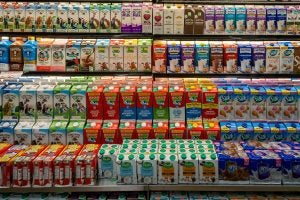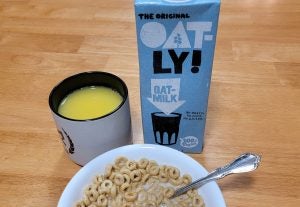Even as consumption of plant-based milk alternatives increases, newly published research shows that most milk alternatives come up short when stacked against the nutritional completeness of real dairy milk.
This science in the Journal of the Academy of Nutrition and Dietetics found that milk alternatives were generally lower in protein and saturated fatty acids than dairy milk, with high variability in added sugars content. In fact, the data discovered a high nutritional variability between alternative milk product categories, as well as within the categories themselves (meaning not all oat milks deliver the same nutritional values).
Current dietary guidance primarily relies on dairy milk as a source of key nutrients of public health concern, including calcium and vitamin D.
“Considering the findings from the present study and prior studies, there is a need to ensure consumers are aware that many plant-based milk alternative products in the marketplace today are not nutritionally equivalent to dairy milk,” the study’s authors wrote.
They suggested that improved product labeling requirements may help to educate shoppers.

The peer-reviewed research, titled, Assessing the Nutrient Content of Plant-Based Milk Alternative Products Available in the United States and published in June, showed that fortified soy-based products most closely mimic the nutrient content of dairy milk. Approximately 70 percent of plant-based milk alternatives were fortified with both calcium and vitamin D.
Milk alternatives had a total of about $2.8 billion in sales in 2021, with almond “milk” being the most popular plant-alternative in the U.S. As recently as 2023, fluid consumption of both real dairy and plant-based alternatives declined, though plant-based versions fell further year-over-year, giving dairy an increased market share.
The new Academy of Nutrition and Dietetics research sought to compare the nutritional content of plant-based milk alternatives between categories (e.g., soy, almond, and oat) and with dairy milk. It evaluated the nutritional content of 219 plant-based milk alternatives from 21 brands available in the U.S. marketplace, using data from the University of Minnesota Nutrition Coordinating Center’s database.
» Related Reading: ‘Plant-based’ demand spurs innovation in milk alternatives
Most plant-based milk alternatives are lower in protein, saturated fatty acids, and sodium than dairy milk but have added sugars. The data also showed that potassium is typically lower in milk alternatives and that most such products have only small amounts of fiber and iron (oat ‘milk’ is the exception in regards to fiber).
Of course, the nutritional content varied considerably among the different products — the researchers repeatedly called it “highly variable.” They said this should factor into how people use tools that depend on food groups, such as the U.S. Department of Agriculture’s MyPlate, which is the informational platform that replaced the long-popular Food Guide Pyramid.
“These findings highlight the importance of communicating the nutritional differences between plant-based milk alternatives and dairy milk to consumers,” the researchers said.

The researchers note that the popularity of plant-based milk alternatives has implications for dietary guidelines, and they recognize how labeling discussions at the federal level are ongoing, with many plant-based milk alternative companies already pivoting their branding:
“In 2023 the Food and Drug Administration published draft labeling recommendations that would ask manufacturers of plant-based products using the term milk in their name to include a voluntary statement describing how the product differs nutritionally from dairy milk. This guidance would apply to products with a nutrient composition that does not match dairy milk,” the paper said.
It goes on to cite the DAIRY PRIDE Act, which was introduced in 2023 to restrict the use of the term milk to products that nutritionally match dairy milk, and the adoption of some alternative brands to preemptively use juice or beverage in place of “milk” on their labels.
The research team cautioned that because the milk-alternative market is changing so quickly, with products being added and amended regularly, the findings cannot be generalized beyond the 219 alternatives that were used in the study.

